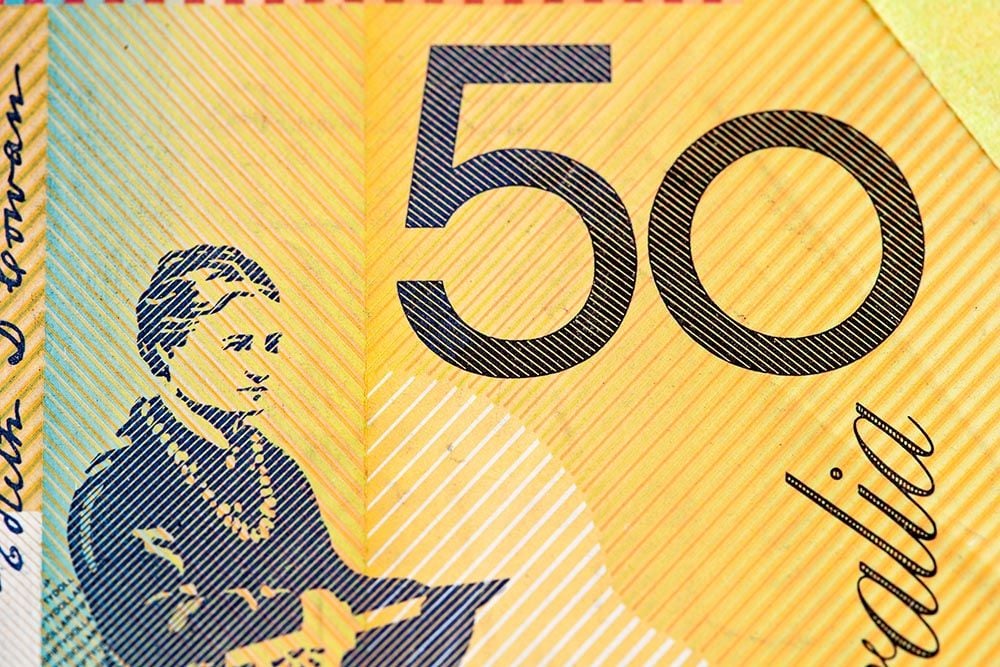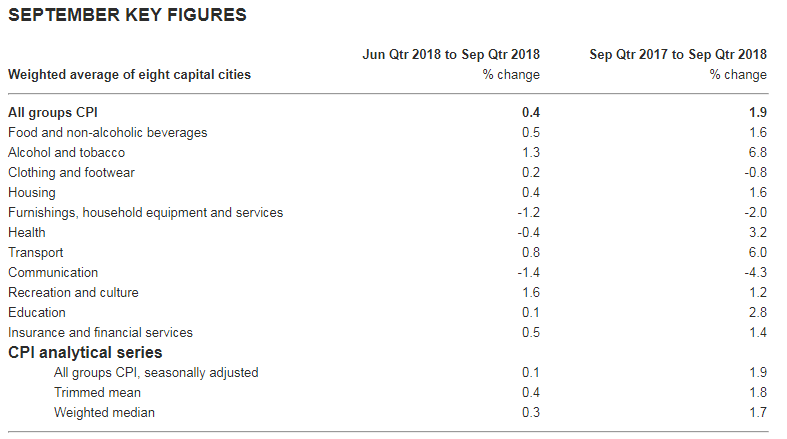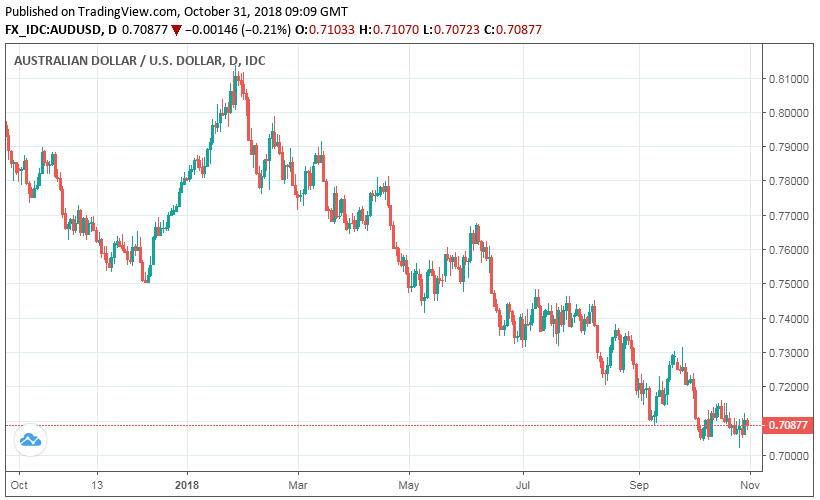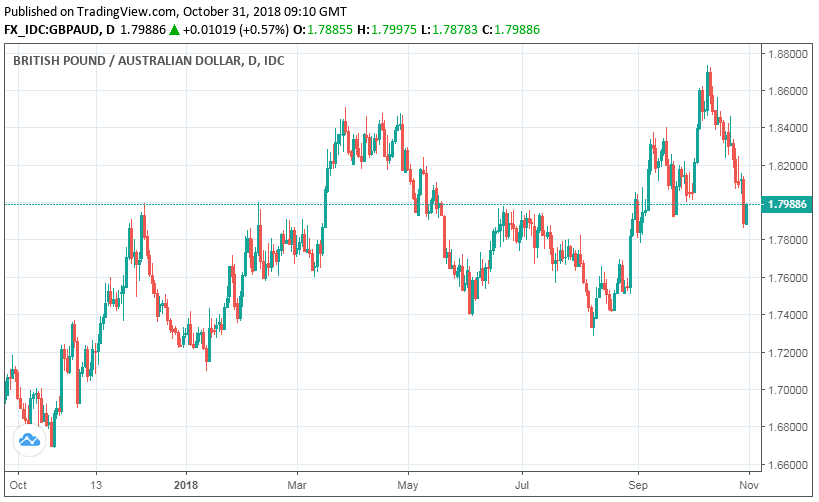The Australian Dollar Outlook Darkens after Inflation Disappoints for the Eighth Quarter and China's Manufacturing Sector Stumbles
- Written by: James Skinner
-

© Greg Brave, Adobe Stock
- AUD weakens after eighth consecutive inflation disappointment.
- Weak price pressures to ensure RBA remains on the sidelines.
- Chinese manufacturing slump adds to headwinds for the AUD.
The Australian Dollar stumbled Wednesday after an eighth consecutive inflation disappointment vindicated the market for its pessimism about the outlook for interest rates down under, and as data suggested the Chinese economy is beginning to creak under the pressure of U.S. tariffs.
Australian inflation rose at an annualised rate of 1.9% during the third-quarter, unchanged from the previous period and in line with the consensus.
But the more important trimmed mean measure of inflation, which excludes the most volatile 30% of items from the goods basket, held steady at 1.8% when economists had looked for it to rise to 1.9%.
Rising prices of holidays, accommodation, tobacco and petrol provided the most support to the inflation rate although these upward pressures were undermined by a double-digit decline in the cost of childcare.
"Arguably the more notable miss for the market was on the average of the core measures which left the annual rate at 1.7% (consensus 1.9%). This is the lowest annual rate on the core read for six quarters. From a monetary policy perspective however, it's broadly in line with the RBA's expectations," says Gareth Aird, an economist at Commonwealth Bank of Australia.

Above: Australian Bureau of Statistics table showing inflation changes by category.
Both headline and trimmed mean inflation numbers are beneath the lower bound of the Reserve Bank of Australia's (RBA) 2% to 3% inflation target, but they are in line with the bank's forecasts for the final months of 2018. Inflation has been below target for much of the last four years.
"Following the December quarter 2017 CPI we argued that searching for inflation in the Australian economy has been a fruitless as Vladimir and Estragon’s wait for Godot. This has not changed as we are still waiting to see how long this record breaking performance can continue," says Justin Smirk, an economist at Westpac.
Markets care about inflation because it has implications for interest rates, which are the primary tool that central banks use to manage price pressures, as well as the driver behind most moves in exchange rates.
Changes in rates are only normally made in response to movements in inflation but impact currencies because of the push and pull influence they have on international capital flows and their allure for speculators.
"Our preliminary estimate for the 2018 Q4 CPI is 0.7%qtr which will see the annual pace lift a touch to 2.0%yr as the recent rise in petrol prices makes a larger contribution in the December quarter," says Smirk. "Under our current scenario, even with a modest lift in housing costs and rising fuel prices, inflation is expected to be at, or just under, 2.0%yr all the way out to end 2019."
The RBA has held its interest rate at a record low of 1.5% for two years, citing weak inflation pressures and a debt laden household sector that it says is ill-equipped to handle higher borrowing costs.
RBA officials are widely regarded as biding their time and hoping for a pickup in Australian wage growth which, ever since 2013, has been running beneath the 3% level the bank is targeting. It is thought wage growth would help lift inflation.
"As long as no solution emerges in the US-China trade conflict and no rapid uptrend in Australian inflation emerges, the RBA will continue to take its time with rate hikes and will stick to its steadfastly neutral approach. As a result the AUD is lacking any basis for significant gains against the USD," says Antje Praefcke, an analyst at Commerzbank.

Above: AUD/USD rate shown at daily intervals.
The AUD/USD rate was quoted 0.12% lower at 0.7088 early in the midweek session but has declined 9% in 2018.
The Pound-to-Aussie rate was up 0.48% at 1.7982 but has risen close to 4% this year.

Above: Pound-to-Australian-Dollar rate shown at daily intervals.
The Aussie has long enjoyed support from interest rates that were typically higher than those elsewhere in the developed world, although it no longer has any interest rate advantage over the US and Canadian Dollars.
The UK-Australia yield gap has also narrowed from 1% to 0.75% ever since November 2017. This has contributed to now-steep losses for the Australian Dollar in 2018.
Advertisement
Bank-beating GBP/AUD and AUD/USD exchange rates! Get up to 5% more foreign exchange by using a specialist provider to get closer to the real market rate and avoid the gaping spreads charged by your bank when providing currency. Learn more here
China Creaks Under Strain of Tariffs
Wednesday's price action comes after the latest China Federation of Logistics and Purchasing PMI surveys revealed a slowdown in the manufacturing and services sectors of the world's second largest economy during October.
China's manufacturing PMI, an index that measures activity and sentiment about the business outlook among manufacturing companies, fell to its lowest level for more than two years in October.
"All five of the PMI components declined and new orders saw a particularly sharp fall. Softer foreign demand doesn’t appear to be the main culprit," says Julian Evans-Pritchard, an economist at Capital Economics.
A decline in new work orders, mostly from overseas, was behind the latest lurch lower in index. Demand for Chinese products may have been hurt during October by tariffs imposed by President Donald Trump on goods imported into the U.S. from China.
President Trump has imposed tariffs of 10% or more on $250 billion of China's annual exports to the U.S. and has threatened to include all of the country's $500 odd billion of goods sold to the U.S. each year if it does not change its "unfair" trade policies.
China has retaliated with levies of its own, although they apply to only around $60 billion of U.S. goods.
Trump told Fox News Monday he is confident of striking a "great deal" that ends the tariff conflict with China. The were made just one month away from the G20 summit in Buenos Aires, where Trump and President Xi Jingping are expected to hold talks.
This is important for the Aussie because the Antipodean currency is underwritten by Australia's mammoth commodity trade with the world's second largest economy. That means whenever the Chinese economy or currency gets hurt, so too does the Australian Dollar, and vice versa.
Advertisement
Bank-beating exchange rates! Get up to 5% more foreign exchange by using a specialist provider to get closer to the real market rate and avoid the gaping spreads charged by your bank when providing currency. Learn more here




